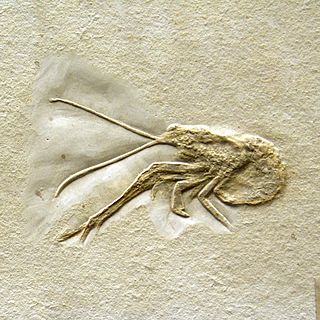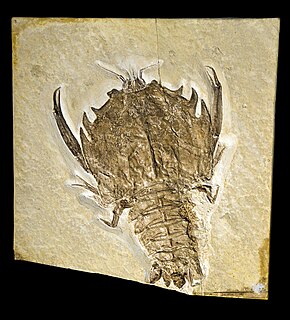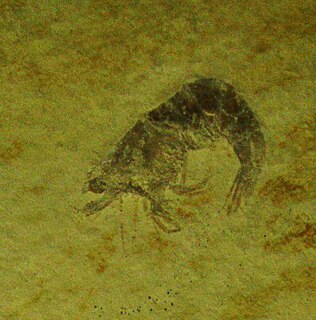Related Research Articles

The Caridea, commonly known as caridean shrimp or true shrimp, are an infraorder of shrimp within the order Decapoda. They are found widely around the world in both fresh and salt water.

Crabs are decapod crustaceans of the infraorder Brachyura, which typically have a very short projecting "tail" (abdomen), usually hidden entirely under the thorax. They live in all the world's oceans, in fresh water, and on land, are generally covered with a thick exoskeleton, and have a single pair of pincers. Many other animals with similar names – such as hermit crabs, king crabs, porcelain crabs, horseshoe crabs, and crab lice – are not true crabs, but many have evolved features similar to true crabs in a process of carcinisation.

The Crato Formation is a geologic formation of Early Cretaceous (Aptian) age in northeastern Brazil's Araripe Basin. It is an important Lagerstätte for palaeontologists. The strata were laid down mostly during the early Aptian age, about 113 million years ago, in a shallow inland sea. At that time, the South Atlantic was opening up in a long narrow shallow sea.

The Decapoda or decapods are an order of crustaceans within the class Malacostraca, including many familiar groups, such as crayfish, crabs, lobsters, prawns, and shrimp. Most decapods are scavengers. The order is estimated to contain nearly 15,000 species in around 2,700 genera, with around 3,300 fossil species. Nearly half of these species are crabs, with the shrimp and Anomura including hermit crabs, porcelain crabs, squat lobsters making up the bulk of the remainder. The earliest fossil decapod is the Devonian Palaeopalaemon.

The Achelata is an infra-order of the decapod crustaceans, holding the spiny lobsters, slipper lobsters and their fossil relatives.

Eucarida is a superorder of the Malacostraca, a class of the crustacean subphylum, comprising the decapods, krill, Amphionides and Angustidontida. They are characterised by having the carapace fused to all thoracic segments, and by the possession of stalked eyes.

Hippoidea is a superfamily of decapod crustaceans known as sand crabs, mole crabs, sand bugs, or sand fleas.

Mecochirus is an extinct genus of lobster-like decapod crustaceans, containing 17 species.

Scyllarus arctus is a species of slipper lobster which lives in the Mediterranean Sea and eastern Atlantic Ocean. It is uncommon in British and Irish waters, but a number of English-language vernacular names have been applied, including small European locust lobster, lesser slipper lobster and broad lobster.

Albuneidae is a little-known family of specialized burrowing sand crabs. There are 50 extant species as well as nine fossil species that have been described. Fossil specimens have been described from the Cretaceous, Miocene and Oligocene.
Ambilobeia is an extinct genus of prawn which existed in Ambilobé, Madagascar during the Triassic period. It contains the species Ambilobeia karojoi.

Eryonidae is a family of fossil decapod crustaceans which lived from the Upper Triassic to the Lower Cretaceous. It contains four genera: An aggregation of three unidentified eryonids was reported in 2012 inside a Late Jurassic ammonoid of the species Harpoceras falciferum; they represent the earliest evidence of gregarious behaviour in decapods.

Ifasya is an extinct genus of prawn. It contains the species Ifasya madagascariensis and Ifasya straelini, and was named in 1995 by Alessandro Garassino and Giorgio Teruzzi. It existed in Madagascar during the Lower Triassic period.

Koelga is an extinct genus of prawn in the order Decapoda. It contains the species Koelga curvirostris and Koelga muensteri.
Longitergite is an extinct genus of prawn which existed in Russia during the Lower Miocene period. It contains a single species.
Acanthinopus gibbosus is an extinct species of shrimp placed in its own genus, Acanthinopus, which has not been assigned to a family. It was found in Norian sediments of the Zorzino Limestone in northern Italy.
This list of fossil arthropods described in 2018 is a list of new taxa of trilobites, fossil insects, crustaceans, arachnids and other fossil arthropods of every kind that were described during the year 2018, as well as other significant discoveries and events related to arthropod paleontology that are scheduled to occur in the year 2018.

The Calcare di Sogno is a geological formation in Italy, dated to roughly between 183-181 million years ago and covering the Toarcian stages of the Jurassic Period in the Mesozoic Era. Thallatosuchian remains are known from the formation.
This list of fossil arthropods described in 2020 is a list of new taxa of trilobites, fossil insects, crustaceans, arachnids and other fossil arthropods of every kind that are scheduled to be described during the year 2020, as well as other significant discoveries and events related to arthropod paleontology that are scheduled to occur in the year 2020.

The Moltrasio Formation also known as Lombardische Kieselkalk Formation is a geological formation in Italy. This Formation mostly developed on the Lower ot Middle Sinemurian stage of the Lower Jurassic, where on the Lombardian basin tectonic activity modified the current marine and terrestrial habitats. Here it was developed a series of marine-related depositional settings, represented by an outcrop of 550–600 m of grey Calcarenites and Calcilutites with chert lenses and marly interbeds, that recovers the Sedrina, Moltrasio and Domaro Formations. This was mostly due to the post-Triassic crisis, that was linked locally to tectonics. The Moltrasio Formation is considered a continuation of the Sedrina Limestone and the Hettangian Albenza Formation, and was probably a shallow water succession, developed on the pasive margin of the westernmost Southern Alps. It is known due to the exquisite preservation observed on the Outcrop on Osteno, where several kinds of marine biota have been recovered.
References
- ↑ Alessandro Garassino & Sergio Bravi (2003). "Palaemon antonellae new species (Crustacea, Decapoda, Caridea) from the lower Cretaceous "Platydolomite" of Profeti (Caserta, Italy)". Journal of Paleontology . 77 (3): 589–592. doi:10.1666/0022-3360(2003)077<0589:PANSCD>2.0.CO;2.